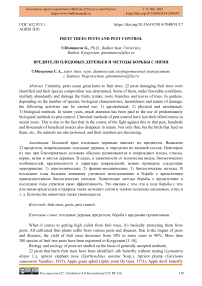Fruit trees pests and pest control
Автор: Momunova Gulzat
Журнал: Бюллетень науки и практики @bulletennauki
Рубрика: Сельскохозяйственные науки
Статья в выпуске: 6 т.9, 2023 года.
Бесплатный доступ
Currently, pests cause great harm to fruit trees. 22 pests damaging fruit trees were identified and their species composition was determined. Some of them, under favorable conditions, multiply abundantly and damage the fruits, trunks, roots, branches and leaves of trees. In gardens, depending on the number of species, biological characteristics, harmfulness and nature of damage, the following activities can be carried out: 1) agrotechnical; 2) physical and mechanical; 3) biological methods. In recent years, much attention has been paid to the use of predominantly biological methods in pest control. Chemical methods of pest control have lost their effectiveness in recent years. This is due to the fact that in the course of the fight against this or that pest, hundreds and thousands of beneficial insects also disappear in nature. Not only that, but the birds that feed on them, etc., the animals are also poisoned, and their numbers are decreasing.
Fruit trees, pests, pest control
Короткий адрес: https://sciup.org/14127768
IDR: 14127768 | УДК: 632.913.1 | DOI: 10.33619/2414-2948/91/17
Текст научной статьи Fruit trees pests and pest control
Бюллетень науки и практики / Bulletin of Science and Practice
When it comes to getting high yields from fruit trees, it’s basically protecting them from pests. All cultivated fruit plants suffer from various pests and diseases. Due to the impact of pests and diseases, the yield of fruit trees decreases from 30% in some cases to 90%. More than 300 species of fruit tree pests have been registered in Kyrgyzstan [1-10].
Biology and ecology of pests are studied on the basis of generally accepted methods.
-
22 pests that harm fruit trees have been identified: silk butterfly without mating ( Lymantria dispar L.), apricot elephant nose ( Epirhynchites auratus Scop.), Apricot plump ( Eurytoma samsonowi Vassiliev, 1915), Apple green aphid ( Aphis pomi De Geer, 1773), Apple devil butterfly
( Cydia pomonella (Linnaeus, 1758)), pouch witness ( Coleophora hemerobiella (Scopoli, 1763)), acacia shield ( Parthenolecanium corni (Bouché, 1844)), leaf moths (Tortricidae).
Some of which are considered the most dangerous: silk moth without mating ( Lymantria dispar L.), leaf mealyworms (Tortricidae), apple-green aphid ( Aphis pomi De Geer), Mealybug ( Coleophora hemerobiella Scop.), apple blossoming spit beak ( Parthenolecanium corni Bouche).
In the Batken region, the species composition of the main pests of fruit trees was 22 insect species (Insecta), which belong to 5 orders and 14 genera.
Species composition of fruit trees pests
Order: Lepidoptera
Family: Noctuidae
Subfamily: Hadeninae
Cosmia subtilis Staudinger, 1888
Family: Coleophoridae
Genus: Coleophora Hübner, 1822
-
C. hemerobiella (Scopoli, 1763)
-
C. lineolea (Haworth, 1828)
Family: Lasiocampidae
Subfamily: Macromphaliinae
Malacosoma parallela (Staudinger, 1887)
Family: Tortricidae
Archips rosana (Linnaeus, 1758)
Grapholita funebrana (Treitschke, 1835)
Laspeyresia pomonella (Linnaeus, 1758)
Family: Geometridae
Apocheima cinerarius (Erschoff, 1874)
Pterotocera armeniacae Djakonov, 1949
Erannis defoliaria (Clerck, 1759)
Family: Lymantriidae
Lymantria dispar Linnaeus, 1758
Family: Yponomeutidae
Yponomeuta padella Linnaeus, 1758
Family: Gelechiidae
Recurvaria nanella (Denis & Schiffermüller) 177 5[
Order: Hymenoptera
Family: Eurytomidae
Genus: Eurytoma Illiger, 1807
-
E. schreineri Schreiner, 1908
-
E. samsonowi Vassiliev, 1915
Order: Coleoptera
Family: Attelabidae
Rhynchites ferghanensis Nevskij, 1929
Family: Buprestidae
Chrysobothris affinis subsp. nevskyi Richter, 1944
Order: Homoptera
Family: Coccidae
Parthenolecanium corni Bouché, 1844
Sphaerolecanium prunastri Fonsc.,1873
Family: Aphididae
Aphis pomi De Geer, 1773
Order: Hemiptera
Family: Aradidae
Stephanitis pyri Fabricius, 1775
Mechanical destruction of pests on trees with the help of something or manually is a physico-mechanical method. In the fight against garden pests, berries that have fallen to the ground are collected and burned. Kerosene can be used to destroy silk moth eggs without mating. In the garden, harvesting can begin immediately after harvesting and be carried out until early spring. At the same time as indicated, they should scrape the eggs from the trees and bury them in deeply dug earth.
The method of protection from pests in the garden using living organisms is a biological method. The living organisms themselves are used in pest control, for example. parasitic and predatory entomophages, microbiological preparations, etc. This method is not dangerous for humans, animals and the environment.
The article discusses the pests of fruit trees and methods of control. Recently, the use of a biological pest control method has become the best way to preserve nature and get clean fruits and vegetables.
Список литературы Fruit trees pests and pest control
- Childers N. F., Morris J. R., Sibbett G. S. Modern fruit science. Orchard and small fruit culture // Modern fruit science. Orchard and small fruit culture. 1995. №Ed. 10.
- Бенкевич В. И. Массовые появления непарного шелкопряда в европейской части СССР. М.: Наука, 1984. 143 с.
- Каменева И. С., Каменева И. Анализ способов защиты растений в РФ // Новости науки в АПК. 2019. №3. С. 363-368.
- Воронцов В. В. Садовые растения от А до Я. М.: Фитон XXI, 2013. 367 с.
- Клюге Н. Ю. Современная систематика насекомых. СПб.: Лань, 2000. 332 с.
- Крыжановский О. Л. Состав и распространение энтомофаун земного шара. М.: Товарищество науч. изд. КМК, 2002. 237 с.
- Момунова Г. А. Биоэкологические особенности сортов абрикоса в условиях Баткенского региона // Вестник Ошского государственного университета. 2015. №1. С. 119-124.
- Момунова Г. А., Тешебаева З. А., Шамшиев Б. Н. Основные вредители абрикоса в условиях Баткенского региона и методы борьбы с ними // Наука. Образование. Техника. 2015. №2 (52). С. 218-226.
- Момунова Г. А., Миралы кызы А. Баткен өрүктөрүнүн гүлдөө жана бышуу мөөнөтүнө абиотикалык факторлорунун тийгизген таасири // Известия ВУЗов Кыргызстана. 2019. № 11. С. 42-48.
- Momunova G. A., Tukhtaev T. M., Anara M. K., Khalmurzaev A. N., Teshebaeva Z. A. Developing an integrated plan of harvest protection as a tool of improving food supply security in Kyrgyzstan // IOP Conference Series: Earth and Environmental Science. 2019. С. 012119.


